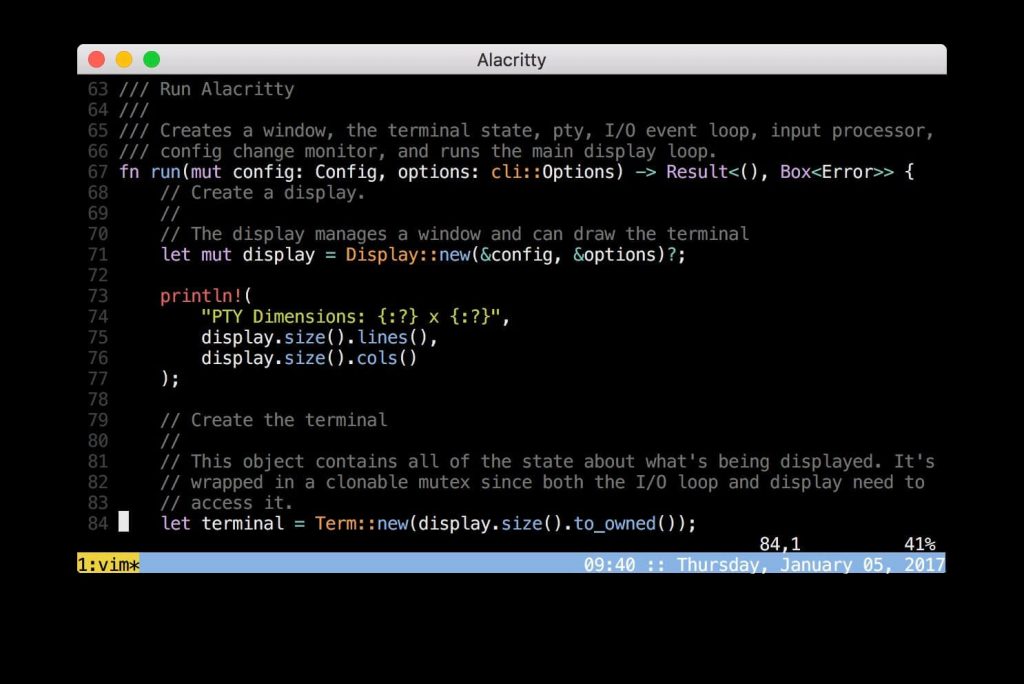

Then you can apply it using the name of the file: pycritty -t custom This: colors : # Default colors primary : background : '0x292d3e' foreground : '0xbbc5ff' # Normal colors normal : black : '0x101010' red : '0xf07178' green : '0xc3e88d' yellow : '0xffcb6b' blue : '0x82aaff' magenta : '0xc792ea' cyan : '0x89ddff' white : '0xd0d0d0' # Bright colors bright : black : '0x434758' red : '0xff8b92' green : '0xddffa7' yellow : '0xffe585' blue : '0x9cc4ff' magenta : '0xe1acff' cyan : '0xa3f7ff' white : '0xffffff' You can make your own custom themes by creating new theme files with theĬorrect format, ~/.config/alacritty/themes/custom.yaml should look like Note that the fonts must be installed on your system. You can also specify a different font for each font type: fonts : Alias : normal : Normal Font Name bold : Bold Font Name italic : Italic Font Name When applied using pycritty -f Alias, the previous format will beĬonverted into the alacritty equivalent: font : normal : family : Font Name italic : family : Font Name bold : family : Font Name Pycritty load SomeCoolConfig # Apply downloaded configĬheck help for all available options: pycritty -hįonts are configured at ~/.config/alacritty/fonts.yaml with this format: fonts : Alias : Font Name
#Alacritty onedark install#
Pycritty install -config -name SomeCoolConfig Pycritty -theme breeze # Apply downloaded theme Install themes and configs from URLs: pycritty install -theme Save multiple configs and reuse them later: pycritty save ThisConfig Or with an AUR helper like yay yay -S pycrittyĬhange your current config: pycritty -font UbuntuMono -font-size 14 -opacity 0.95 -padding 3 3 ~/.xprofile if you haven't already: export PATH = $HOME/.local/bin: $PATHĪlso if you are an Arch user you can install from the AUR (only the program will be installed) git clone

Your shell won't find the pycritty command. Make sure to have ~/.local/bin directory in your $PATH, otherwise Or if you want them all: pip install -install-option = "-themes=all" pycritty Soft-wrap indicator (see the editor.By default, only the program itself will be installed, but you can installĭefault themes from config/themes: pip install -install-option = "-themes=onedark,dracula,nord" pycritty

Style for inlay hints of kind type (LSPs are not required to set a kind) Style for inlay hints of kind parameter (LSPs are not required to set a kind) Ruler columns (see the lers config)ĭefault style for inlay hints of all kinds Same as ui.text but when the text is inactive (e.g. Statusline mode during select mode ( only if lor-modes is enabled) Statusline mode during insert mode ( only if lor-modes is enabled) Statusline mode during normal mode ( only if lor-modes is enabled) Line number for the line the cursor is on Line at which debugging execution is paused at Indicator for the line at which debugging execution is paused at, found in the gutter completion - for completion doc popup UIīreakpoint indicator, found in the gutter.These scopes are used for theming the editor interface: text - URL and image descriptions in links.1, 2, 3, 4, 5, 6 - heading text for h1 through h6.modifier - Storage modifiers like static, mut, const, ref, etc.type - The type of something, class, function, var, let, etc.storage - Keywords describing how things are stored.directive - Preprocessor directives ( #if in C).special - String interpolation brackets.bracket - Parentheses, angle brackets, etc.member - Fields of composite data types (e.g.builtin - Reserved language variables ( self, this, super, etc.).documentation - Documentation comments (e.g.symbol - Erlang/Elixir atoms, Ruby symbols, Clojure keywords.OverviewĮach line in the theme file is specified as below: key =, string.raw/.unquoted)?

💡 The names "default" and "base16_default" are reserved for built-in themesĪnd cannot be overridden by user-defined themes. The directory might have to be created beforehand. Creating a themeĬreate a file with the name of your theme as the file name (i.e mytheme.toml) and place it in your themes directory (i.e ~/.config/helix/themes or %AppData%\helix\themes on Windows). To use a theme add theme = "" to the top of your config.toml file, or select it during runtime using :theme.


 0 kommentar(er)
0 kommentar(er)
